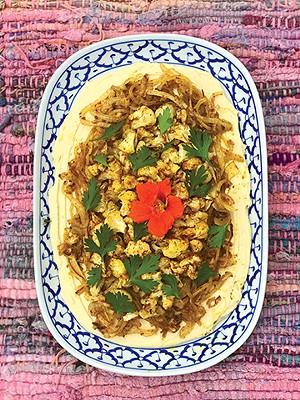For a long time, an old jar of tahini has resided in a lonely corner in the back of the fridge. It was one of those ingredients that I had purchased for one purpose only – making homemade hummus, which I rarely made.
I’ve always felt that the appeal of grocery store hummus was due more to the garlic or roasted pepper toppings than the pureed chickpeas.
A few years ago I drove Bertha Bus down to New Orleans to do a weeklong stage (culinary apprenticeship) with Chef Justin Devillier (2016 James Beard Award Winner – Best Chef South) at his restaurant La Petit Grocery. Finding a place to park a 35-foot school bus in a big city is always a challenge, so I arrived in New Orleans’ Garden District well-ahead of my 1 p.m. start time. Lunch service was in full swing and there was a line for tables, so I was told to come back at 1 p.m. One of the cooks suggested that I grab lunch at Shaya, a new Israeli restaurant that had just opened up across the street. Shaya’s menu had a whole section devoted to hummus with various topping options. I ordered the hummus with curried onions and cauliflower. Served with freshly made pita bread still warm from the wood-burning oven, the dish remains one of my most profound taste memories.
When I later found the recipe for Shaya’s curried onion and cauliflower hummus online, I was eager to recreate the dish at home. Though I followed the recipe faithfully, the resulting dish, though still quite good, just wasn’t as special as I remembered it from Shaya. The culprit, it turned out, was that old jar of tahini that had been hiding out in the back of the fridge.
Tahini is nothing more than an oily paste made of ground sesame seeds. It has been part of Mediterranean, Middle Eastern and North African cuisine for centuries. Hulled seeds are roasted and crushed into an oily paste. The richest, most flavorful tahini is made from Ethiopian humera sesame seeds.
A call to Shaya revealed that the tahini used in their heavenly hummus was from Philadelphia-based Soom Foods. Soom was founded in 2013 by three sisters and focuses the marketing of its high-quality tahini directly to chefs. Soom sells for 75 cents an ounce on Amazon, whereas the more widely available Ziyad brand sells for 30 cents an ounce. A batch of Shaya’s hummus recipe, which yields 5 cups, calls for ½ cup of tahini. A half-cup of Soom will cost $3, whereas a half cup of Ziyad will set you back $1.20. To determine if the higher cost was justified, I set up a blind side-by-side tasting. The unanimous opinion was that the Soom brand had a clean, fresh sesame taste whereas the Ziyad brand had a bitter flavor. This flavor difference carried over into the end product, which was deemed by all my reviewers to be significantly superior.
Most brands of tahini available in the U.S. are made from sesame seeds that come from Mexico or India. Soom uses the more costly Ethiopian white humera sesame seeds. A more careful, gentler roasting process utilized in small-batch production results in a tahini that is easier to use and is more shelf-stable. Mass-produced tahini separates into a thick solid mass with an inch of oil on top and requires aggressive stirring.
Small-batch tahini can go 6-8 months without separating.
Tahini has great nutritional benefits. According to nutritionist Emma Whitnall, “Tahini contains the heart-protective antioxidant sesamol, which is anti-inflammatory and can help with arterial health.” Whipped into a spread, tahini can be a nutritious, nut-free substitute for peanut butter (most peanut butter contains added sugar and palm oil).
SHAYA’S CURRIED ONION AND CAULIFLOWER HUMMUS
1 pound dried chickpeas, soaked overnight and drained
8 garlic cloves, peeled
1 teaspoon baking soda
½ cup tahini
½ cup lemon juice
1/3 cup extra-virgin olive oil
½ teaspoon ground cumin
Kosher salt
Olive oil, for sautéing
½ pound cauliflower, cut into ½-inch florets
2 teaspoons curry powder
1 large onion, halved and thinly sliced
Chopped parsley for garnish
In a large saucepan, cover the chickpeas, garlic and baking soda with 2 inches of water and bring to a boil. Reduce to a simmer and cover. Stir every 15 minutes until chickpeas are tender, about 45-50 minutes. Add water if necessary. Drain and puree in a food processor until smooth and creamy.
With machine running, slowly add the tahini, lemon juice, 1/3-cup extra virgin olive oil and the cumin. Season with salt.
In a skillet, heat ¼ inch of olive oil. Sautee cauliflower over medium heat until deeply browned. Remove cauliflower to a paper towel-lined bowl and add 1 teaspoon curry powder and mix well. Season with salt. Add onion to skillet with a pinch of salt and sauté over medium-high heat until soft and lightly browned. Add 1 teaspoon curry powder and sauté a few minutes more. Season with salt.
Transfer hummus to a serving bowl and top with the curried onion and cauliflower. Drizzle with olive oil and add garnish with parsley.
WHIPPED TAHINI
Culinary alchemy occurs when you whip tahini and seasonings in a food processor and slowly add water. It becomes creamy, nutty and smooth, and is good both at room temperature or chilled. It has become my go-to topping for grilled or roasted vegetables.
Makes about 2 1/2 cups.
1 1 ⁄2 cups tahini, well-shaken
3 or 4 cloves garlic, crushed
1 tablespoon fresh lemon juice
1 teaspoon sea salt
In a food processor, combine the tahini, garlic, lemon juice and salt, and process for 4-6 minutes, until the mixture lightens in color. With the motor running, gradually add up to 1 cup water, processing until the mixture is super smooth and creamy, like mayonnaise; the mixture will seize at first before emulsifying into a smooth spread. Store in a lidded container in the refrigerator for up to three days.
Recipe from Poole’s: Recipes and Stories from a Modern Diner by Ashley Christensen published by Ten Speed Press.
Contact Peter Glatz at [email protected]


















